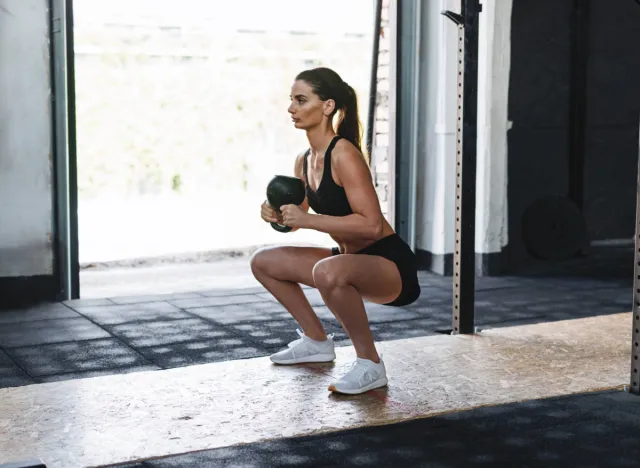People Swear by 'Hybrid Training' To Build Muscle & Endurance—Here's How It Works

Do you want stronger, bigger muscles while improving your cardio game? If so, we're putting "hybrid training" on your radar, which trainers say is an ideal way to build muscle, improve your cardiovascular fitness, and condition your entire body. Hybrid training is all about integrating various exercises within one workout. This means performing resistance training and cardio in the same session rather than on separate days to achieve great results.
"If you regularly do cardio and lift weights, you'll improve different areas of your health simultaneously," explains Domenic Angelino, CPT from Trainer Academy. "Aerobic exercise like running or cycling is effective at improving your heart health. Resistance exercise, like lifting weights or doing pushups, is effective at improving your bone, muscle, and nervous system health. Combined, you're making progress on many different fronts at once." Not only that; you're being more efficient with your time!
Now, let's dive into how you can start integrating hybrid training into your routine and its many benefits.
How does hybrid training work?

Many gym-goers have their go-to cardio and strength days. There's nothing wrong with that; however, by splitting things up, you may not be getting the biggest bang for your buck. That's where hybrid training comes in clutch.
"When you do different types of training on different days, the effects of each workout don't interact with each other that much. You might find that soreness and fatigue from a heavy leg workout could impact your running speed the next day, but the effects are limited," Angelino explains. "By contrast, hybrid training necessitates that the different types of exercises you do will interact with each other. You do them back to back within the same workout, so the effects of whichever you do first will influence what happens next. Whichever one you do second can even impact the type of exercise that came before it."
Hybrid training can help you soak up the most benefits in one combined workout. This is handy when you are short on time, as you don't have to plan separate cardio and weight training days.
"Hybrid training is very time efficient and can lead to your heart doing more work than it normally would during a resistance training session because of the involvement of cardio," Angelino adds.
Hybrid training is helping people build muscle and cardiovascular fitness.
People on TikTok are engaging in hybrid training to strengthen their bodies, build endurance, and improve their runs more efficiently.
Hybrid athlete Ramses Principe shared a TikTok video of a weekly training split for lifting and running and outlined the benefits of combining these two forms of exercise. Principe wrote, "Enhanced performance: Build a stronger, more resilient body to power through runs with ease. Injury prevention: Strengthening muscles and improving mobility reduces the risk of common running injuries. Total-body conditioning: Achieve a balanced physique and improve overall fitness levels."
Another TikTok user and online fitness coach, Emily Jane, shared in a video how she uses hybrid training to build muscle while running. Jane explained, "Find a solid workout routine that benefits both muscle growth, but also your running goals. That's why movements like single-leg leg press and hip thrust are always a staple for me and my hybrid coaching clients. [In addition,] eat like your life depends on it … it's also crucial to keep your protein intake high, otherwise you'll find you won't build muscle."
Sample hybrid workout routines:

There are several ways you can organize your own hybrid training plan, and here are some examples to help you get started.
Example #1: Alternate between cardio and resistance training
4 rounds of:
- Dumbbell Goblet Squat, 8 reps
- Sprinting, 45 seconds
4 rounds of:
- Dumbbell Bench Press, 8 reps
- Sprinting, 45 seconds
4 rounds of:
- Lat pulldowns, 8 reps
- Sprinting, 45 seconds
4 rounds of:
- Kettlebell swings, 20 reps
- Running at a fast pace, 3 minutes
- Slow jogging, 10 minutes
Example #2: Cardio first
- Running at a moderate pace, 30 minutes
- Dumbbell Deadlift, 4 sets of 8 reps
- Dumbbell Goblet Squat, 4 sets of 8 reps
- Dumbbell Bench Press, 4 sets of 8 reps
- Dumbbell Bent-over Row, 4 sets of 8 reps
Example #3: Resistance training first
- Barbell Back Squat, 4 sets of 8 reps
- Dumbbell Romanian Deadlift, 4 sets of 8 reps
- Dumbbell Incline Bench Press, 4 sets of 8 reps
- Cable Seated Row, 4 sets of 8 reps
- Running at a moderate pace, 30 minutes









